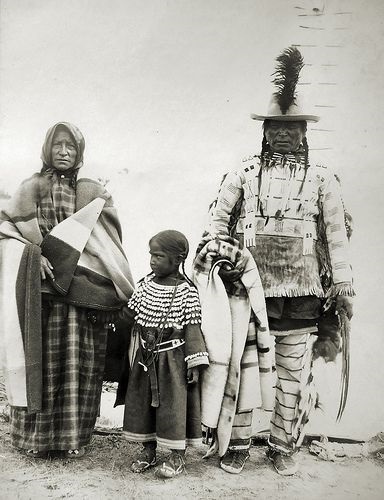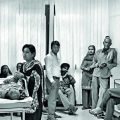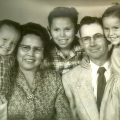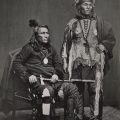
Like most of the Indian nations that are currently associated with the Northern Great Plains, the Assiniboine migrated out on the Plains after the European invasion and its fur trade began pushing Native peoples to the west. The Assiniboine spoke a Siouan language and at one time they had been a part of the Yanktonai Sioux living in the Lake Superior region of present-day northern Minnesota and southwestern Ontario. The Assiniboine split over from the Yanktonai in the 1600s and began their migration west. During the eighteenth century, their migrations brought them into the Northern Plains of Alberta and Montana.
The Northern Plains tribes depended on hunting and gathering for their subsistence. Their annual round was not random nomadism. The bands had to understand the location of the food resources and to time their travels so that they would arrive in specific locations at a time when these resources were available.
The most important game animal on the Northern Plains was the buffalo. In his book Land of the Nakoda: The Story of the Assiniboine Indians, James Long writes:
“To the Assiniboine, the buffalo was more than an animal. It was the staff of life. No other animal gave so much to the people as that great shaggy creature.”
Among the Assiniboine, horse-mounted hunters supervised by the Soldiers’ Society and using bows and arrows would surround the buffalo herd. In an hour’s time, 80-100 hunters could kill 100-500 buffalo. The hunter who killed the animal claimed the hide and the choicest pieces of meat. All who aided in the butchering were entitled to a portion of the meat.
For housing, the Assiniboine used a three-pole tipi (lodge) which averaged about 31 feet in circumference and required 12 hides for a cover. Assiniboine lodges always faced south. The lodges were owned by the women and were set up by them. The tipi was occupied by a nuclear family along with some other relatives, such as a widowed grandmother. Sometimes the Assiniboine lodges were painted with pictures of the war honors of the man who lived there.
The Assiniboine used chokecherry, ash, and scrub oak for their bows. The length of the bow varied and was designed to suit its user. James Long reports:
“On some bows a sharpened prong, made from the horn of an elk, was attached to one end. These were used in battle as bayonets after a warrior had shot away all his arrows.”
Prior to the horse, each Assiniboine family had to have six to twelve dogs, each capable of carrying up to fifty pounds. The dogs were named by the women. James Long reports:
“They spoke to them like persons, either scolded them or praised them whenever the dogs deserved it.”
Among the Assiniboine, a young man would not seek marriage until he had participated in a war party, and ideally not until he had counted coup. A marriage proposal was accompanied by gifts to the bride’s family. If the proposal was accepted, then the woman would simply go to live with the man at his village.
With regard to polygyny, Dennis Smith, in his history of the Fort Peck Assiniboines in The History of the Assiniboine and Sioux Tribes of the Fort Peck Indian Reservation, Montana, 1800-2000,reports:
“A husband wishing other wives often asked permission from his wife’s family to marry one of her younger sisters.”
Among the Assiniboine, families tended to be small: usually only one to three children. Children were generally spaced five to seven years apart. Children would generally continue to breastfeed until about their fourth year. Like other Plains tribes, the Assiniboine did not whip or handle their children roughly.
In general, children were instructed by example, usually by adults of their own gender. Grandparents were often important teachers. Dennis Smith writes:
“Like most Native tribes, Assiniboines instructed primarily in a nurturing and positive environment, in which children were praised for successful accomplishments.”
Assiniboine babies received a name about 3-4 weeks after birth. The name would usually be given by a successful warrior or a holy man. Raymond DeMallie and David Reed Miller, in their entry on the Assiniboine in the Handbook of North American Indians, report:
“Girls’ names were generally kept throughout life, but young men frequently received new names in recognition of their first brave deed.”
The name of a deceased grandfather or other male relative might be given to a warrior who had counted coup many times.
Assiniboine girls were tattooed when they were about 12 years of age. Women’s tattoos were considered to be decorative and included a round spot on the forehead, transverse lines on the cheeks, lines from the mouth to the chin, and rings around the wrists and upper arms. Assiniboine men were tattooed only after having counted coup in battle. Men’s tattoos tended to be elaborate, covering the chest and arms.
In most of the Plains tribes, divorce was easy. A man might simply pick up his things and leave, or his wife might tell him to leave. For the Assiniboine, James Long reports:
“Marriages were dissolved merely by living apart.”
Concerning Assiniboine divorce, Dennis Smith writes:
“Divorce was an accepted practice, and usually older children remained with the husband, and the younger ones returned with the mother to her family.”
The primary political unit among the Assiniboine was the band and there was no political structure which tied the bands together into a tribe. Among the Assiniboine, the chief (huká) was selected by merit rather than heredity. James Long writes:
“A chief’s son was not always the next chief. A person who had made a name for himself in warfare, hunting, and kindness to the poor, was often made next chief.”
James Long summarizes the qualifications for being a chief:
“The requirements were that a chief-to-be must have a good war record, be a successful hunter, possessor of many horses for domestic use, and horses for use as buffalo runners.”
Raymond DeMallie and David Reed Miller report:
“Because generosity was an important qualification for leaders, wealth was a prerequisite for chieftainship.”
As with other Plains groups, the Assiniboine chief acted as the leading member of the band council and had no authority to compel anyone to do anything. The council was composed of men who had achieved success in war or in hunting.
The Assiniboine Soldiers’ Society was composed of warriors appointed by the band council. According to Raymond DeMallie and David Reed Miller:
“The function of the soldiers was to serve as police, maintaining order within the camp and supervising hunts and camp moves.”
In addition to the Soldiers’ Society, the Assiniboine also had a number of men’s societies which were closely associated with war and which also had spiritual or sacred significance. The No Flight Society had two lances which they carried into battle. These would be thrust into the ground and the society’s members would not retreat until the enemy had been vanquished. The Buffalo Bull Society was composed of middle-aged men and leaders.
The Assiniboines also had a number of women’s societies, including the Dance Without Robes Society and the Female Elk Society.
Among the Assiniboine, war parties intent on raiding for horses were fairly small (12 warriors or less) and the warriors would leave on foot. Leaders of horse raiding parties usually fasted to obtain a vision of a successful raid. According to James Long:
“When a war leader had a suitable vision, he called a number of able warriors to his lodge and told them of his intentions.”
They would then pick the warriors they wanted to accompany them. The actual raid was usually carried out under the cover of darkness. The war party would travel in single file with the war leader taking the lead and young men on their first raid traveling in the rear.
Regarding an Assiniboine raid, James Long writes:
“When a war party raided a camp to take horses, everyone had to look out for himself. The group agreed to meet at a certain place and, if all went well, they gathered there to plan the return home. But if the enemy found out about the raid, then each one pursued the best course he knew.”
Assiniboine war parties organized for revenge were usually larger and might have 100-300 warriors.
The Assiniboine warriors would make offerings to the wolf before a war party and they would sing wolf songs. Assiniboine warriors would often wear wolf skins for camouflage. However, the wolf hat was generally worn only by the scouts. Archaeologist James Keyser, in article in American Indian Art, reports:
‘Among all of these groups, serving as a scout was a position with well-defined responsibilities worthy of a war honor when successfully performed.”




Leave a Reply